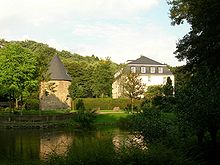Lordship of Hardenberg

1) Langenberg and Deilbach
2) Hardenberg Castle (today in Neviges)
3) Neviges
4) Tönisheide (today Velbert-Neviges)
The rule Hardenberg was in the late Middle Ages and the early modern period a sub-rule of the Duchy of Berg and, besides villages Neviges and Langenberg the farming communities (from north to south) Dill village , Voss neck , Rottberg , Rich Rath , Wallmichrath , North Rath , Windrath , Kuhlendahl , High Altitude , Untensiebeneick , Dönberg , Kleine Höhe and Obensiebeneick . It was abolished in 1808.
history
According to Bender, who presented the first comprehensive account of the Hardenberg rule in 1879, a noble family of the Lords of Hardenberg was first documented in 1145, at that time with the title of count , later referred to as dynasts or barons . However, they were only able to maintain their independence from the up-and-coming neighboring territories of Berg and Mark until 1354, when they sold their rule to Gerhard von Jülich-Berg and settled themselves at Hardenstein Castle near Witten.
After that, Hardenberg was a Bergisches Amt , which, however, with Hardenberg Castle was regularly pledged to various nobles for large sums. In 1496, the castle and office passed to Bertram von Gevertshagen as a hereditary fief . In 1529 the rule came to the von Bernsau family by inheritance .
When it was enfeoffed in 1651, Hardenberg was first referred to as Bergische Unterherrschaft . Like the other Bergische Unterherrschaft Broich , it was largely independent. The residents did not pay the Bergisch taxes, but the subordinate money to be paid to the duke was transferred to them. At the Bergische customs posts they were treated like strangers. Although the subjects were able to appeal to the Bergisch court in Düsseldorf, the Lords of Hardenberg had full jurisdiction, as the execution site in the Grosse Höhe family shows.
In the 1570s, Wilhelm IV von Bernsau , the owner of the rule, brought Reformed preachers to the church in Neviges. The first Bergische Synod took place under his protection in 1589. The congregation in Langenberg, on the other hand, only turned from Lutheranism to the teaching of the Reformed in 1593 . After Johann Sigismund von Bernsau returned to Catholicism in 1649 and the Franciscans took over pastoral care in 1676 , a Catholic community was formed again. The pilgrimage to a picture of the Virgin Mary brought to Hardenberg in 1680 supported the construction of the monastery, which began in the same year, and the (old) pilgrimage church of St. Mary's Conception, which still exists today, was completed in 1728.
On March 17th, 1698 , Jobst Dietrich von Wendt was enfeoffed with the lordship of Hardenberg. The von Wendt family held power until it was abolished in 1806, while the Napoleonic Grand Duchy of Berg was formed. The Hardenberg rule became the Hardenberg municipality , which became part of the Kingdom of Prussia in 1815 .
economy
In addition to pilgrimage and agriculture, lead mining and alum extraction as well as linen and ribbon production as a domestic trade were of economic importance for the rule. In the farmers' communities of Richrath and Rottberg, located near Velbert , the manufacture of locks has played a role since the 16th century.
Bailiffs
The following officials are documented:
- 1361: Peter von Kalkum, amptman tzo Hardenberghe
See also
Bergische Amt Constitution in 1363
literature
- Ludwig Bender, History of the former rule of Hardenberg in Bergisch from prehistoric times to their abolition, Langenberg 1879, digital
- Kurt Wesoly, City Atlas Neviges , Cologne 2001.
- Albrecht Brendler: On the way to the territory. Administrative structure and office holder of the County of Berg 1225–1380 . Inaugural dissertation, Bonn 2015, pp. 204–211.
Individual evidence
- ↑ Ludwig Bender, p. 77 , accessed on April 21, 2014.
- ↑ Brendler (2015), p. 211.

